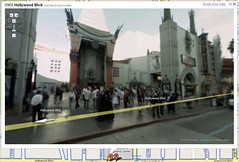Check Out New Google Maps Labs Features
Many Google Maps users may have missed the recently added button, allowing users to opt-in to try out some of the Google Maps Labs beta features. The Labs options can be accessed via the new little icon button found in the upper right of the user-interface, if you’re logged-in to your Google account:
The new features might also reveal some secrets of Google Maps ranking factors. It’s definitely a space that’s well worth watching for local search marketing experts.
Possible Related Posts
Posted by Chris of Silvery on 03/26/2010
Permalink | |  Print
| Trackback | Comments (0) | Comments RSS
Print
| Trackback | Comments (0) | Comments RSS
Filed under: Google, Local Search, Local Search Optimization, Maps, Research and Development, Search Engine Optimization, SEO, Tools, Tricks beta testing, Google Labs, Google-Maps, Local Search, local-SEO
Google Maps Should Consider A Canonical Phone Number Tag
Google Maps, local search engines, internet yellow pages and other online business directories often receive biz listing info from a great many sources and must merge it together (see my description of this in Eric Enge’s interview with me). When this happens, loads of variations in the business’s name, address and even phone number can cause listing data to fail to be merged. All this makes me think we might need a “Canonical Tag” for phone numbers! Read on, and I’ll elaborate… (more…)
Possible Related Posts
Posted by Chris of Silvery on 09/28/2009
Permalink | |  Print
| Trackback | Comments (0) | Comments RSS
Print
| Trackback | Comments (0) | Comments RSS
Filed under: Local Search, Local Search Optimization, Maps, Online Directories, Research and Development, Search Engine Optimization, SEO, Yellow Pages canonical phone number tag, canonical phone tag, canonical tag, Google-Maps, hCard, hcard microformat, local-search-engine-optimization, local-SEO, microformats, phone number, phone numbers, phones, proposed microformat, Yellow Pages
Quova Awarded Patent for Improved Geotargeting
 Quova recently announced that they were awarded a patent for various methods which improve geotargeting accuracy and capability. My understanding is that Quova has been using these methods for quite some time already, prior to receiving the patent.
Quova recently announced that they were awarded a patent for various methods which improve geotargeting accuracy and capability. My understanding is that Quova has been using these methods for quite some time already, prior to receiving the patent.
Here’s Quova’s description of the innovations:
“Quova’s newly added patent describes a method for determining the geographic location of an Internet user based upon combining trace routes, user registration information, host names with textual patterns that reveal geolocation information and Internet Service Provider (ISP) service area information. These trace routes describe the pathways by which data moves through the Internet. Each node or ‘hop’ in the trace route is identified by an IP address. These interconnected nodes can be used to recreate the topology of the Internet. Each geolocation can then be assigned to these IP addresses in order to determine the location of each node, up to and including the end user’s IP address and the geolocation of that end user.”
I previously have written about Quova in my extensive article, (more…)
Possible Related Posts
Posted by Chris of Silvery on 07/28/2009
Permalink | |  Print
| Trackback | Comments (0) | Comments RSS
Print
| Trackback | Comments (0) | Comments RSS
Filed under: Advertising, Best Practices, Local Search, Maps, Research and Development, Security, technology click-fraud, geo targeted ads, geodata, geographic location data, Geolocation, geotargeting, Quova
Text In Street View Could Be Used For Quality Improvement
Philipp Lenssen at Google Blogoscoped observes that Google could potentially use OCR (optical character recognition) to attempt to derive text from signage and such within Google Street View images in order to create further enhancements.

Grauman’s Chinese Theatre in Street View, Los Angeles.
However, I see a much more immediately valuable use that could be put to text scanned from the images — quality improvement of address pinpointing functionality. (more…)
Possible Related Posts
Posted by Chris of Silvery on 08/05/2008
Permalink | |  Print
| Trackback | Comments (0) | Comments RSS
Print
| Trackback | Comments (0) | Comments RSS
Filed under: Google, Maps, Research and Development Google Street View, Google-Maps, Mapping
SMX LoMo Keynote: Gur Kimchi
Gur Kimchi, Principle Architect for Microsoft’s Virtual Earth, also spoke Thursday morning at the SMX Local & Mobile conference in San Francisco.

Gur Kimchi, Principal Architect, Microsoft Virtual Earth
Gur provided a lot of demonstrations of existing and upcoming features from the Virtual Earth teams: (more…)
Possible Related Posts
Posted by Chris of Silvery on 07/28/2008
Permalink | |  Print
| Trackback | Comments (0) | Comments RSS
Print
| Trackback | Comments (0) | Comments RSS
Filed under: Conferences, MSN Search, Research and Development Local Search, Maps, MicroSoft, SMX LoMo, SMX-Local-&-Mobile, Virtual Earth
The Long Tail A Myth? Study Calls It Into Question
A Wall Street Journal Article today cites a study by Anita Elberse, a marketing professor at Harvard’s business school, entitled, “Should You Invest in the Long Tail?“, which finds evidence that in the online world, consumers gravitate towards the most-popular items just as in the offline world.
The Long Tail, if you don’t already know, refers to a theory promoted by a book by Chris Anderson titled “The Long Tail”, which describes a sort of niche strategy of business, such as employed by Amazon.com or Netflix, that sell a large number of unique items in relatively small quantities. The idea is that while you can obviously sell large numbers of a few popular items (the “head”), the cumulative, smaller number of sales of all your many less-popular items (the “tail”) might easily add up to a far greater total amount.

“Head” items shown in red, “Tail” items shown in blue
Here at Netconcepts, we’ve been promoting the Long Tail concept in relation to natural search marketing for quite some time, since we’ve witnessed how its application can directly improve a business’s overall sales numbers. Indeed, businesses often get the most sales per item for their most popular products, but those products are also often the most competed on the internet, and sometimes the hardest to promote as a result. Even in the cases of top online retailers, we’ve seen that greater bulks of traffic and associated sales may often come from the bulk of less-popular Tail products. (more…)
Possible Related Posts
Posted by Chris of Silvery on 07/02/2008
Permalink | |  Print
| Trackback | Comments Off on The Long Tail A Myth? Study Calls It Into Question | Comments RSS
Print
| Trackback | Comments Off on The Long Tail A Myth? Study Calls It Into Question | Comments RSS
Filed under: Marketing, Monetization of Search, Reference Material, Research and Development, Search Engine Optimization, SEO Chris Anderson, niche marketing, The Long Tail
NebuAd – New Twist on Behavioral Targeting for Online Ads
News stories this week highlighted Silicon Valley startup NebuAd, which recently unveiled their behavioral targeting network at ad:tech.
Behavioral ad targeting is nothing new on the internet, and I easily recall it being offered in one form or another as far back as about 1999. In fact, 24/7 Real Media currently offers behavioral targeting through their ad network as just one case in point. So what’s new with this incarnation is the way in which NebuAd collects data to base the targeting upon. NebuAd’s innovative twist on behavior targeting is based upon monitoring individuals’ internet browsing habits through their ISP, essentially seeing all the sites and pages that a user visits. (more…)
Possible Related Posts
Posted by Chris of Silvery on 12/11/2007
Permalink | |  Print
| Trackback | Comments Off on NebuAd – New Twist on Behavioral Targeting for Online Ads | Comments RSS
Print
| Trackback | Comments Off on NebuAd – New Twist on Behavioral Targeting for Online Ads | Comments RSS
Filed under: Advertising, Paid Search, Research and Development, Security, technology behavioral targeting, internet ads, internet advertising, Nebu Ad, NebuAd, online ads, online-advertising
WikipediaVision Mashes Up With Google Maps and Wikipedia
An addictive little mashup called WikipediaVision has combined Google Maps with live data on updates from the English Wikipedia to display the geolocation of people editing articles in near real-time. The map rapidly pans back and forth across the world, pinpointing the locations of users who have just edited an article, and displaying the name of the article and its hyperlink.
It’s interesting and hypnotic to sit and watch where in the world (more…)
Possible Related Posts
Posted by Chris of Silvery on 11/05/2007
Permalink | |  Print
| Trackback | Comments Off on WikipediaVision Mashes Up With Google Maps and Wikipedia | Comments RSS
Print
| Trackback | Comments Off on WikipediaVision Mashes Up With Google Maps and Wikipedia | Comments RSS
Filed under: Maps, Research and Development, Tools FlickrVision, Google-Maps, Maps, Mashups, Wikipedia, WikipediaVision
New Breed of People Search Engine Launches: Spock.com
A little startup called Spock.com has moved into public beta today for their official public launch – previously they were only available to a handful of invite-only beta-testers. Spock is to white pages what Google Maps was to yellow pages – Spock is a sort of people search engine that pulls data from many different sites together to automatically form personal profiles of individuals. The service also allows one to search for people who match up with certain criteria like celebrities, kidnapped children, billionaires, sudoku fans, “journalists killed in Iraq”, “Baptist women who love to travel”, etc.

Spock is one of a new breed of people search engines which pulls data in from a variety of online sources including MySpace, LinkedIn, My Yahoo!, Wikipedia, company websites, blogs, and other sources to compose these composite profiles which include photos, descriptions, links to people related to the person in question, and tag lists of common keywords. Check out this search I did for “Danny Sullivan”:
And, here’s the profile Spock generated for the search engine marketing “Danny Sullivan”:
This automatic generation of profiles from other data sources, similar to a meta search engine, is not all that new, of course – ZabaSearch has been touted for doing similar stuff to compose info on people out of various public records, sort of like a poor man’s background search. And, ZoomInfo has worked to build a directory of searchable business profiles of individuals. IceRocket also used to have a metasearch engine that pulled in data from a handful of various singles/personals sites.
What makes Spock a bit different is how they’re actively composing these profiles from sources that really haven’t been associated with one another previously, and making them publicly available, for “free” (eventually paid for by ad revenue, of course). While the general public likely hasn’t been aware of it, the CIA or NSA has actually also been working on a similar sort of search engine system which automatically composes secret dossiers of information on individuals from a multitude of sources including credit card information, criminal databases, as well as many of the same online sources used by these web services like ZabaSearch, ZoomInfo, and Spock.
Possible Related Posts
Posted by Chris of Silvery on 08/08/2007
Permalink | |  Print
| Trackback | Comments Off on New Breed of People Search Engine Launches: Spock.com | Comments RSS
Print
| Trackback | Comments Off on New Breed of People Search Engine Launches: Spock.com | Comments RSS
Filed under: General, Research and Development, Searching people-search, privacy, privacy-concerns, spock, white-pages
New Research Could Improve Google Image Search
New research recently published out of University of California – San Diego could allow Google’s Image Search to easily begin using elements from “true image search” — that is, the ability for software to detect and identify elements appearing within the image itself rather than just relying upon external text metadata to associate keywords with the images. Read on for more details.
Possible Related Posts
Posted by Chris of Silvery on 04/05/2007
Permalink | |  Print
| Trackback | Comments Off on New Research Could Improve Google Image Search | Comments RSS
Print
| Trackback | Comments Off on New Research Could Improve Google Image Search | Comments RSS
Filed under: Google, Image Optimization, Research and Development, Searching Google, Google-Image-Labeler, Google-Image-Search, image-search, Supervised-Multiclass-Labeling






